Building trust in innovation
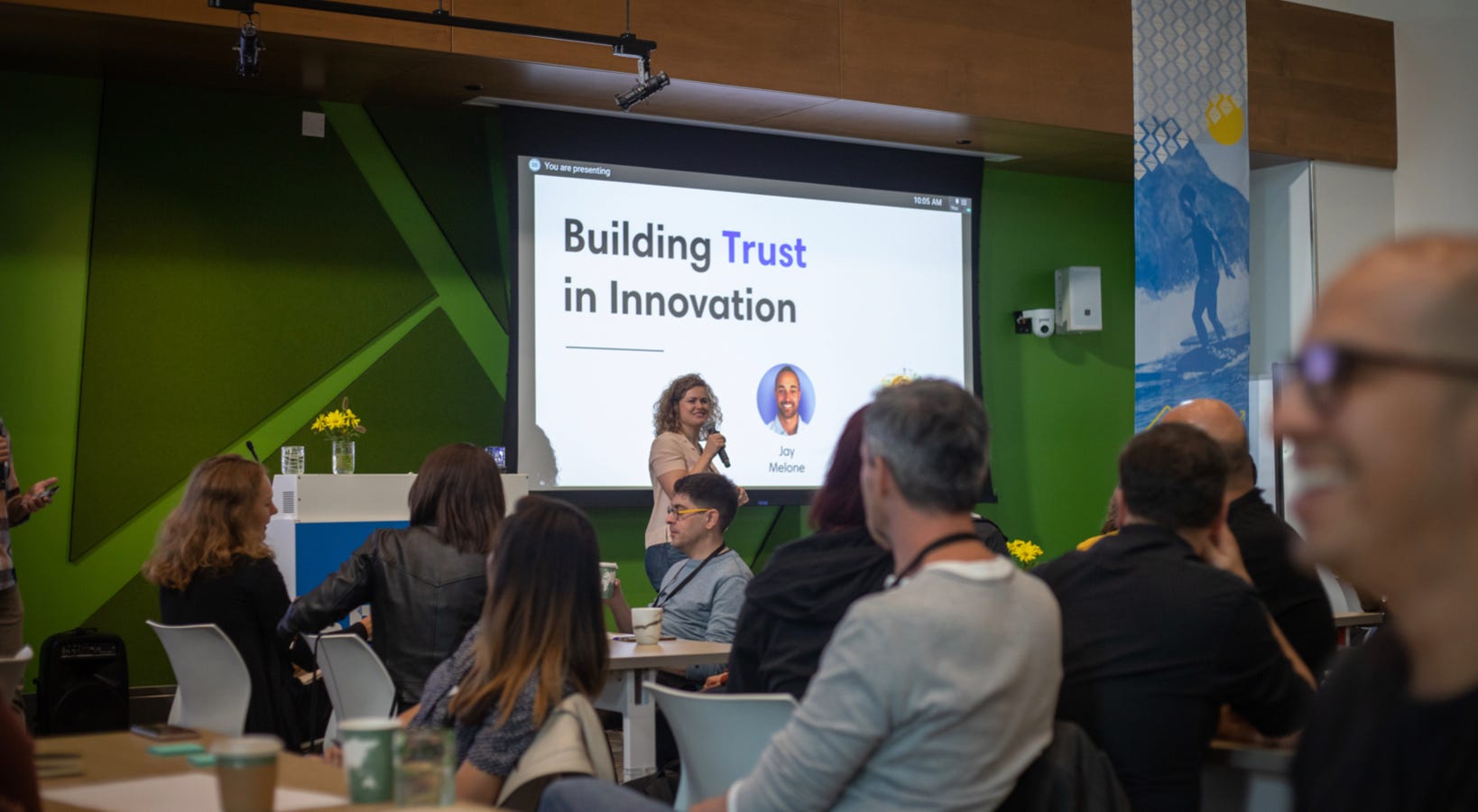
Google Sprint Conference // Building Trust in Innovation by Jay Melone and Holly May Mahoney
As designers and innovators, why are we so quick to practice empathy & compassion with our users but not our fellow team members? The real work required to generate results from innovation programs starts with the relationships we nurture inside our teams.
During this year’s Google Sprint Conference, Holly May Mahoney and I had a chance to collaborate on the critical topic of establishing team-wide trust and vulnerability — the foundation for our projects, programs, and people to be successful.
Here’s a free assessment I created to measure the trust and performance of your team.
When Jay met Holly
A late June summer evening in the Financial District of San Francisco. Kai and I sat across from each other sharing deviled eggs, laughs, and stories of life in the trenches of leading organizational change.
Our conversation twisted and turned, at one point cradling into the topic of team dynamics — of how greatly people’s relationships with one another and themselves impact the work she and I work hard to lead. I shared stories about a team I was in town working with that week — a group of people that wanted so badly to do great things together, but couldn’t help but to cut one another’s ideas down at every pause in the conversation.
Kai leaned forward in her chair, pointed a finger in my direction, and said with the kind of smile someone applies when they know you’ll thank them later,
“I have just the person you need to meet. I think you two would be great to lead a deep dive at this year’s sprint conference.”
And that is how I came to meet Holly May Mahoney.
Holly and I quickly developed an appreciation of the other’s ideas and intentions of applying empathy and vulnerability to re-form teams that are built on trust.
Following Kai’s premonition of our fated collaboration, we designed an arc for one of the Sprint Conference deep dive sessions. Our theme would be: Building Trust in Innovation.
And the guiding question we set out to explore, along with our workshop attendees:
How do we lead and inspire teams charged with innovation, to trust one another and show up?
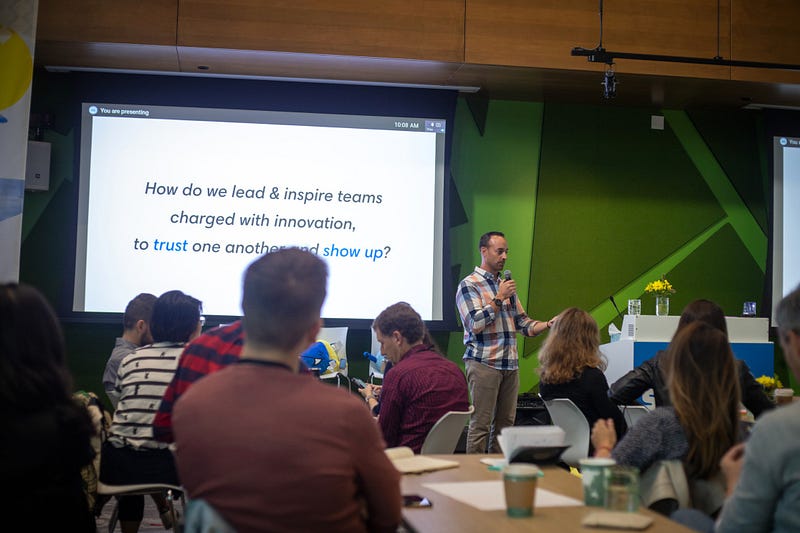
Why trust & vulnerability?
And what do either have to do with innovation?
Imagine you, me, and a few other team members are asked to work together to rethink the experience of our existing flagship product. The product is in its 11th year and has produced 83% of the company’s revenue over the last 15 years. But the market has caught up and sales have been dipping. The hope from senior leadership is that we discover some breakthrough innovations to put our company back on top!
During our research, you discover a customer pain point; only, it’s for a customer that our company has never sold to. The following week is the project’s first design sprint. You feel a pull to voice your findings with the team but you’re nervous what our reaction might be.
You think back to a project you were a part of last year. During one team brainstorm, a colleague was practically laughed out of the room by a VP for suggesting a similarly risky opportunity.
You cautiously sink back into your seat. You decide to keep the idea in your back pocket after seeing some of the ideas from the rest of the team.
And this is how brave ideas like yours die — in a river of distrust, where our fear of being wrong, of looking stupid, of being judged, keep these critical conversations from reaching shore.
What would you have needed from us to encourage you to speak up and share your crazy idea? According to the work Google did within Project Aristotle, psychological safety is the key ingredient that makes for an effective and trusting team. It’s also something many teams fail to place any significance on in the workplace.
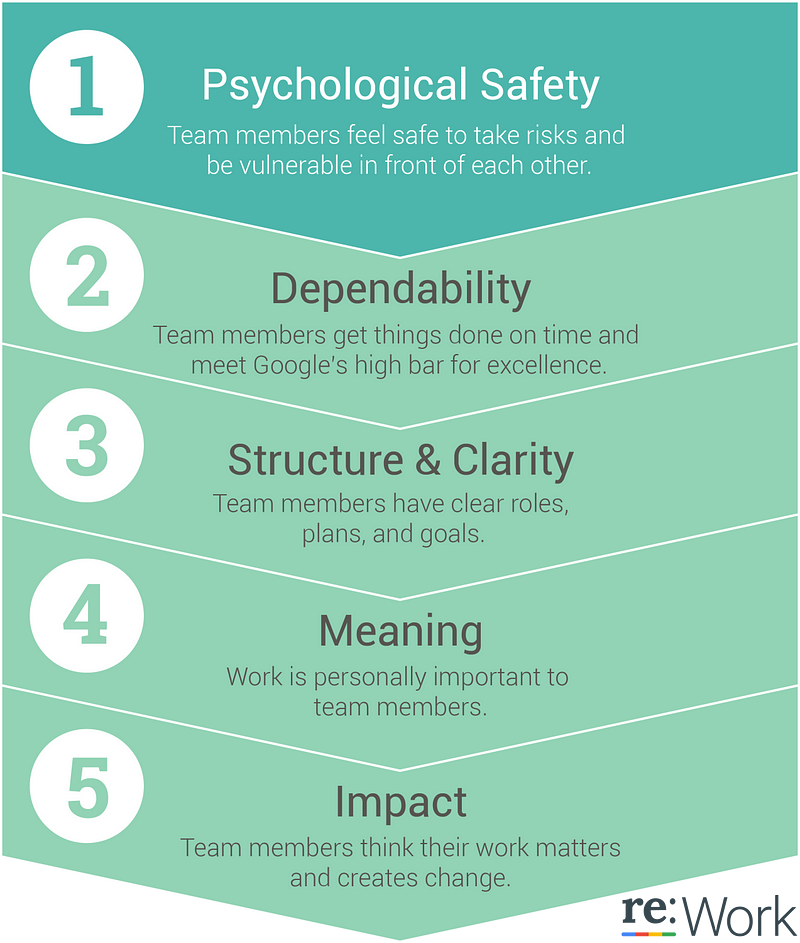
Says who?
In a frighteningly similar percentage of innovation consulting requests Holly and I receive in our separate businesses, a minor fraction express interest in spending any time talking about the health of their teams.
“I‘m not sure that’s relevant… we’re just looking for you to come in and lead our project.”
We also hear things like:
“Sure, I understand. But at this time we need to remain laser focused on the real work.”
Of course, what Holly and I have learned and are unwavering on at this point in our practices, is that bringing safety, dependability, clarity, and meaning to our teams is not only the hard work, but the foundation that enables true innovation to happen.
Honoring change
Innovation happens in the wake of change. But change is not only comprised of curiosity, freedom, and excitement — there is also anxiety, fear, grief, and loss.
According to Bree Groff, far too many leaders and change agents approach change from a mindset of celebration and new beginnings. While that’s certainly part of change, it’s also the last mile. In fact, there are 2 prior stages that we need to be cognizant of:
1. Ending: When the practices, people, and milestones from the past are commemorated.
2. Adjustment: When we face terms that this change brings with it loss.
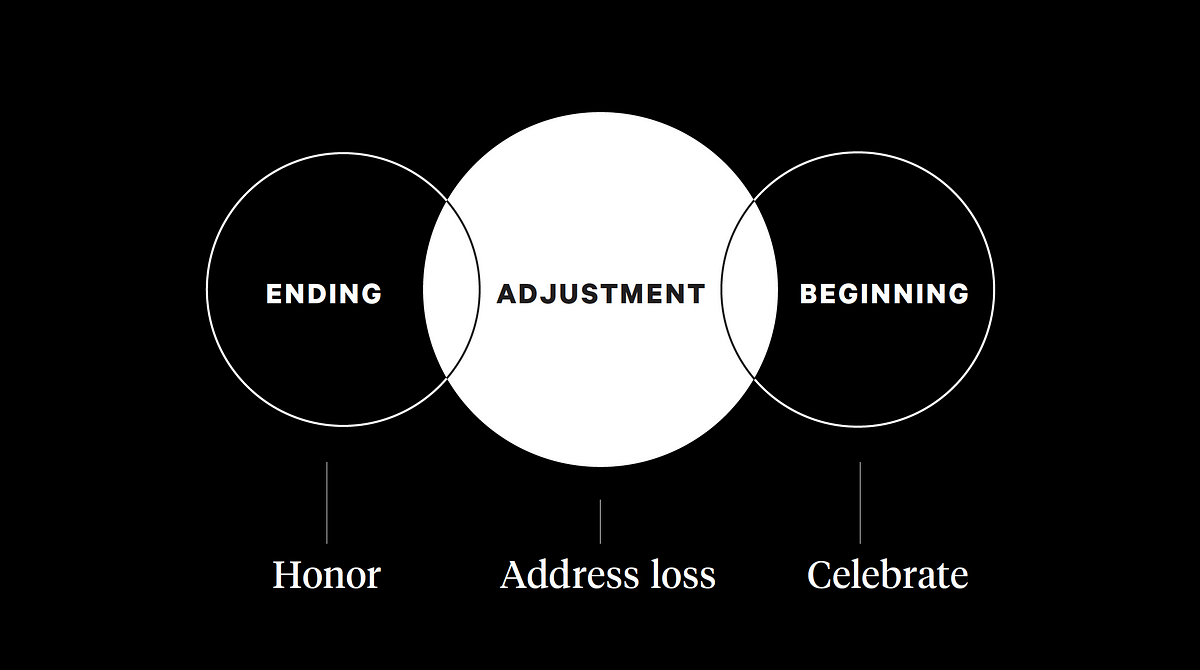
By honoring these first 2 stages and allowing time to reflect and mourn, our people will be ready for the excitement and anticipation of the path ahead.
But re-establishing cultures aligned around trust and vulnerability, and allowing change to take its due course all seem like too much work for our already busy teams to bear.
The truth is, you cannot expect to change a single person, let alone a team or workforce, over the course of a single workshop or off-site. As we learned from Bree, such change requires care and commitment. There are so many relationships, dynamics, milestones, and touchpoints to rethink through a lens of trust and empathy.
The great news, which Holly and I have discovered, and proved with the help of our conference attendees, is that we can take small and steady actions, beginning today.
Getting started with trust
While Holly and I are actively exploring and designing new frameworks for the many milestones that teams endure, we focused on two key team events during our workshop at the Google Sprint Conference:
1. When we’re preparing to kick off a new project
2. When we’re reflecting on a recently completed project
New projects and ICBD
Similar to the cocktail of excitement and anxiety you felt on the first day of school, forming or joining a new team can be dizzying. And yet it’s sobering how few of us take time to honor this critical milestone.
Instead, we learn that we’ve been resourced on a new project via email. The project manager organizes a kickoff call where the agenda allows for 5 minutes of intros, 80 minutes reviewing the project brief, and 5 minutes for Q&A.
During the intros, each person states their name, role, and previous experience. In between turn-taking, the rest of the team uses the free time to purge their inbox.
This is the energy and attention we give to a group of people whom we’ll spend the next 9 months working with.
What if dating worked that way? Would you trust the person that brought their resume to a first date and talked all night about their past accomplishments? I think the real question is, how much would you distrust them.
Checking in
If we want to accomplish major milestones within our teams, we need to give time and space for the group to trust one another. This is true for any team, especially new charters or groups with a past history of operating under toxic conditions and high distrust.
During our workshop, Holly and I introduced a framework that allows for the crucial, foundational conversations to happen within the team. ICBD stands for Intentions, Concerns, Boundaries, and Dreams and was originally created by Alexandra Jamieson and Bob Gower in their book, Getting to Hell Yes.

In short, the group allows each team member to reflect and share their intentions for the work they’re about to do, followed by questions from the rest of the team. This format is followed next for concerns, then boundaries, and finally, dreams.
Since it was important to Holly and I to be fully present and aware during our session, we decided to complete this activity together over a ramen dinner the night before. The project that we used for context was coming together to facilitate this session. We considered and shared with each other, our intentions, concerns, boundaries, and dreams.
Here are the guiding questions to prompt discussion for each area.
Intentions
Why do you want to be a part of this project?
How can this project support your personal goals?
What values of yours led you to get involved?
Concerns
What worries you about the team, our plan, etc?
What do you think will get in our way?
Where will we run into trouble?
Boundaries
What do you need to be at your personal best?
What will keep us from overreaching or burning out?
What rules or standards will help this team be the best?
Dreams
If this goes incredibly well, what will be true?
How will you feel? Where will you be?
What metrics will have shifted?
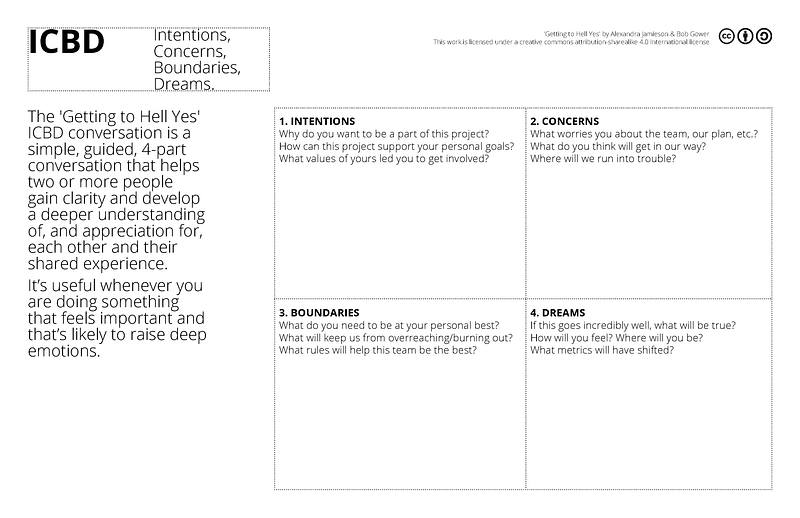
The result
During the session, the attendees really leaned in. There were as many smiling and laughing faces as there were expressions of deep empathy and active listening.
One person in particular caught us off guard with the impact the activity produced for him. He shared:
“I’ve learned more about the people at this table than I know about my colleagues I’ve been working with for a year.”
Here are some additional reflections the group shared:
“We really don’t make enough time for conversations like these. Once people open up, they have so much to say.”
“It felt easier to think and talk about concerns than it did about our dreams. We had loads of concerns and not many dreams.”
“It’s hard to ask questions about someone’s ICBD’s without judgement, or solutioning.”
“I got closer to visualizing my dreams through the dialogue with others. I was able to make them more tangible by getting the support from the table. And it turns out dreams are contagious!”
After exploring how ICBD can be used when teams are coming together, we next spent time considering how teams might reflect at the end of a milestone or project.
Reflecting and 9 Dimensions
Have you ever sat through a project post-mortem or debrief? What happens? Typically they resemble… a meeting. During this meeting, the team lead does most of the talking to recap on behalf of the group. It tends to take the shape of a shit sandwich — celebratory highlights upfront, followed by a rant of Opportunities to improve next time around.
The rest of the team sits mostly silently — no one wanting to be the person that shares critical feedback of the group or a particular person. And even if they did share, would anything really change?
Checking out
Post mortems deserve the same kind of intentional, human relational design that our products and services receive.
During our workshop, Holly and I employed an activity called 9 Dimensions, originally developed by Better Teams.
The goals of adopting such a tool in the context of improving trust and team dynamics are identical to the guideposts we use when applying a design thinking mindset to our projects:
Develop empathy for other people
Invite active participation and listening from everyone
Visualize the ideas and desired outcomes
9 Dimensions is a reflective activity your team can run under different scenarios:
Individually, to reflect on how you’ve operated within a team
Existing teams, to evaluate what’s been working vs. not
New teams, where given a chance to share outside experiences
During the activity, each team member is invited to reflect and rate 9 varying criteria. The good news is that the criteria are completely adaptable to your team, project, environment, and expectations.
Since our session at the Sprint Conference was filled with facilitators and change agents, we asked the group to reflect on a recent sprint or project they had just completed. We asked them to imagine an upcoming opportunity to debrief with their team, in anticipation of an ensuing project together.
The criteria we included for this session included: Communication, Safety, Open Mindset, Sense of Purpose, Accountability, Visualizing Ideas, Build on Top of Others, Negotiating, and Bias.
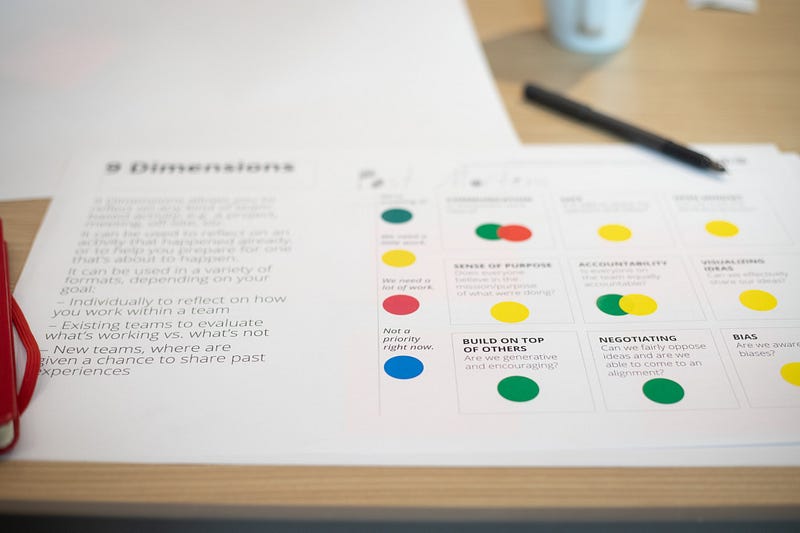
The result
The group appreciated the idea of having an easy to follow, color-code artifact to drive such an important conversation; versus a list of generic topics with cold descriptions.
We also experienced that you can have too much of a good thing. These practices and conversations are deeply emotional and therefore require lots of energy. Placing time between ICBD and 9 Dimensions, or related activities allows everyone to dive back in for the next round of empathically charged conversations.
Here, some final reflections from the group about 9 Dimensions:
“The dot format allowed for quick focus on hot topics instead of going down the list. So often in debrief one person talks and you run out of time. Using this method enables prioritization.”
“I could see myself and my team using this at the end of each day (of a sprint?) as a debrief.”
“It would be great to do this with team leads.”
“It may help to resolve differences in perception within the team.”
“It’s good to have a visual artifact (stickers?) to jog your memory.”
Final reflections
How might we, as facilitators, innovators, and change agents take this work forward within our teams?
What Holly and I learned from this session is that these conversations are as difficult as they are important. It’s scary to be the person that raises their hand, before psychological safety has been established, ask that we invite vulnerability into our work.
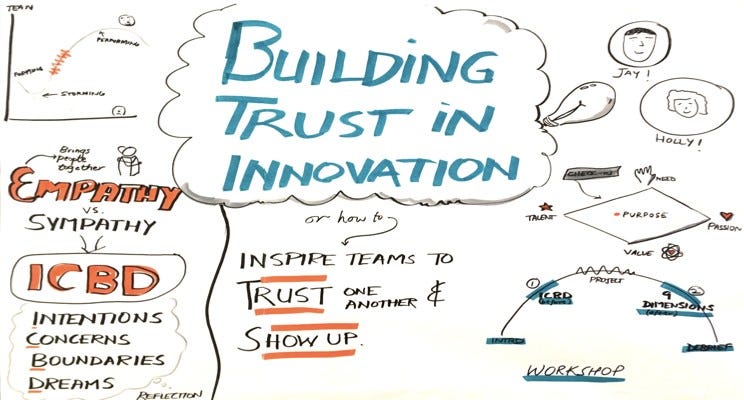
But like we demonstrated inside of our 2-hour workshop, small steps and steady attention will spark lasting momentum. Because innovation is like tending to a garden. Just as we can’t control the weather, we won’t be able to force everyone to accept the change overnight. But with consistent sun and watering, our crops and our people will raise.
What about Holly and I?
We started as two strangers coming together to explore an area within team dynamics that we hoped to inspire more people to lean into. The deep engagement and emotional reactions from the conference attendees validated the need and importance of this topic. Holly and I couldn’t be more committed to continue taking this work forward.
If you’re excited to evolve the conversations and performance inside your teams, contact me or Holly to inquire about having us lead a conference keynote or workshop. We would be thrilled to be involved!
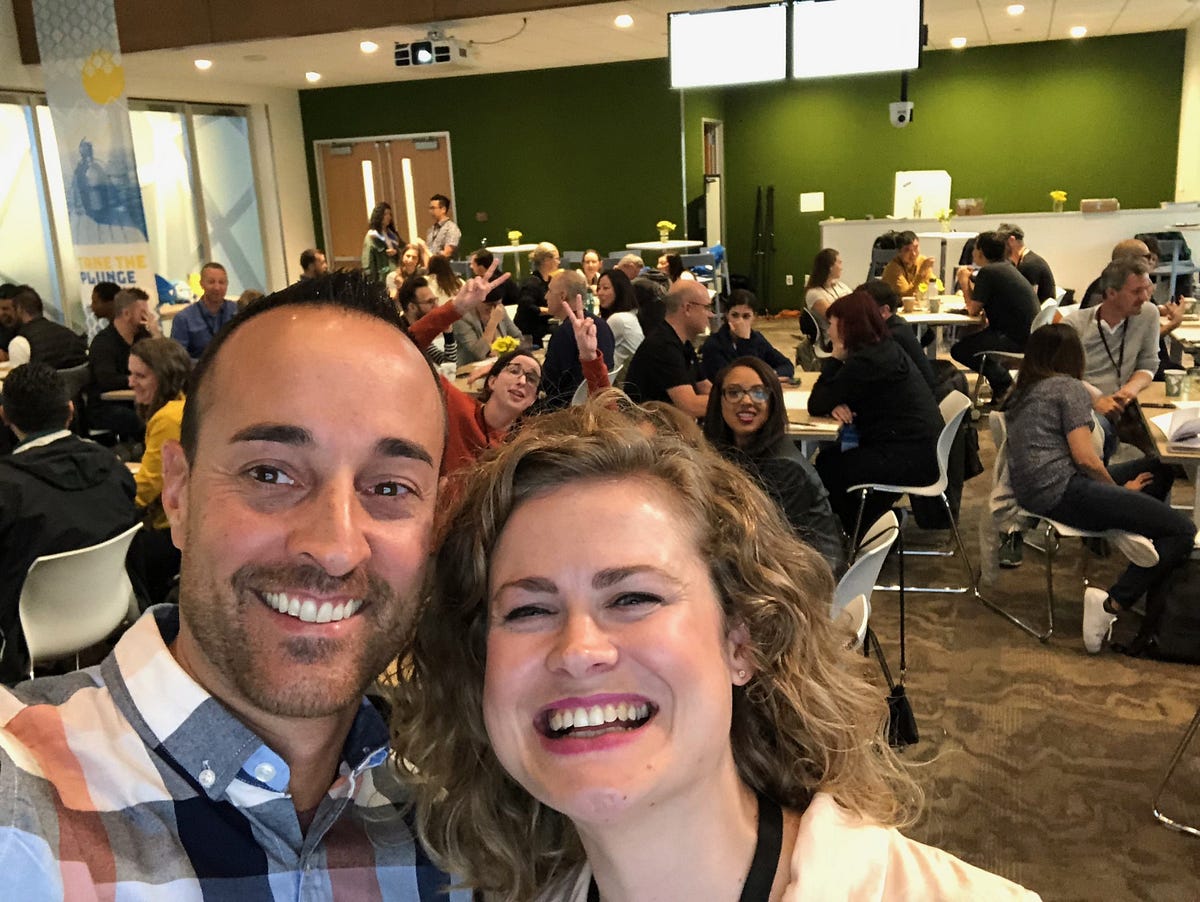
Special thanks to Holly, for her care and commitment during this collaboration. I’m so excited for what we’ll do together next!
Also thanks to Kai Haley, Nicole Rejwan, Sumier Phalake and the rest of the Google team for continuing to support the Sprint community. If you’re interested in attending the annual conference you can learn more here.
Finally, thanks to Chris Federer for the great pics!

